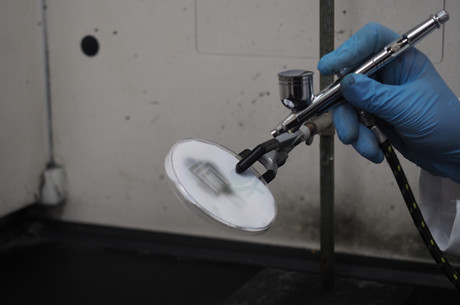'Spray-on antennas' can transmit and direct radio waves

Thanks to a breakthrough from Drexel University’s College of Engineering, installing an antenna could soon be as easy as applying some bug spray.
The promise of wearable devices, functional fabrics, the Internet of Things and their next-generation technological cohort seems tantalisingly within reach. But researchers in the field will tell you a prime reason for their delay is the problem of seamlessly integrating connection technology — namely, antennas — with shape-shifting and flexible ‘things’.
Now, Drexel University researchers have reported on a method for spraying invisibly thin antennas, made from a type of two-dimensional, metallic material called MXene, that perform as well as those being used in mobile devices, wireless routers and portable transducers. Their work has been published in the journal Science Advances.
“This is a very exciting finding because there is a lot of potential for this type of technology,” said Professor Kapil Dandekar, who directs the Drexel Wireless Systems Lab and was a co-author of the research. “The ability to spray an antenna on a flexible substrate or make it optically transparent means that we could have a lot of new places to set up networks — there are new applications and new ways of collecting data that we can’t even imagine at the moment.”

The researchers report that the MXene titanium carbide can be dissolved in water to create an ink or paint. The exceptional conductivity of the material enables it to transmit and direct radio waves, even when it’s applied in a very thin coating.
“We found that even transparent antennas with thicknesses of tens of nanometres were able to communicate efficiently,” said Asia Sarycheva, a doctoral candidate in the A.J. Drexel Nanomaterials Institute. “By increasing the thickness up to 8 µm, the performance of the MXene antenna achieved 98% of its predicted maximum value.”
Preserving transmission quality in a form this thin is significant because it would allow antennas to easily be embedded — literally, sprayed on — in a wide variety of objects and surfaces without adding additional weight or circuitry or requiring a certain level of rigidity.
“This technology could enable the truly seamless integration of antennas with everyday objects which will be critical for the emerging Internet of Things,” Prof Dandekar said. “Researchers have done a lot of work with non-traditional materials trying to figure out where manufacturing technology meets system needs, but this technology could make it a lot easier to answer some of the difficult questions we’ve been working on for years.”

Initial testing of the sprayed antennas suggests that they can perform with the same range of quality as current antennas, which are made from familiar metals, like gold, silver, copper and aluminium but are much thicker than MXene antennas. Making antennas smaller and lighter has long been a goal of materials scientists and electrical engineers, so this discovery is a sizeable step forward both in terms of reducing their footprint as well as broadening their application.
“Current fabrication methods of metals cannot make antennas thin enough and applicable to any surface, in spite of decades of research and development to improve the performance of metal antennas,” said Professor Yury Gogotsi, Director of the A.J. Drexel Nanomaterials Institute, who initiated and led the project.
“We were looking for two-dimensional nanomaterials, which have sheet thickness about a hundred thousand times thinner than a human hair; just a few atoms across, and can self-assemble into conductive films upon deposition on any surface. Therefore, we selected MXene, which is a two-dimensional titanium carbide material that is stronger than metals and is metallically conductive, as a candidate for ultrathin antennas.”
Drexel researchers discovered the family of MXene materials in 2011 and have been gaining an understanding of their properties, and considering their possible applications, ever since. The layered two-dimensional material, which is made by wet chemical processing, has already shown potential in energy storage devices, electromagnetic shielding, water filtration, chemical sensing, structural reinforcement and gas separation.
MXene materials have naturally drawn comparisons to promising two-dimensional materials like graphene, which has itself been explored as a material for printable antennas. The Drexel researchers put the spray-on antennas up against a variety of antennas made from these new materials, including graphene, silver ink and carbon nanotubes. The MXene antennas were 50 times better than graphene and 300 times better than silver ink antennas in terms of preserving the quality of radio wave transmission.
“The MXene antenna not only outperformed the macro and micro world of metal antennas, we went beyond the performance of available nanomaterial antennas, while keeping the antenna thickness very low,” said Babak Anasori, a research assistant professor in the A.J. Drexel Nanomaterials Institute.
“The thinnest antenna was as thin as 62 nm — about a thousand times thinner than a sheet of paper — and it was almost transparent. Unlike other nanomaterials fabrication methods that require additives called binders, and extra steps of heating to sinter the nanoparticles together, we made antennas in a single step by airbrush spraying our water-based MXene ink.”
The group initially tested the spray-on application of the antenna ink on both a rough substrate (cellulose paper) and a smooth one (polyethylene terephthalate sheets). The next step for their work will be looking at the best ways to apply it to a wide variety of surfaces from glass to yarn and skin.
“Further research on using materials from the MXene family in wireless communication may enable fully transparent electronics and greatly improved wearable devices that will support the active lifestyles we are living,” Anasori said.
Light reshapes semiconductors for advanced optical devices
Researchers have shown how light reshapes Janus semiconductors at the atomic scale, enabling...
Novel method to grow ultrathin semiconductors on electronics
Researchers have developed a technique that could speed up the development of next-generation...
Blue LEDs developed to enhance display performance
Researchers have developed a new method for manufacturing light-emitting diodes (LEDs) that emit...




